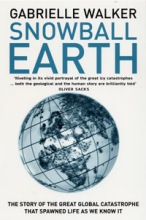
Snowball Earth
Gabrielle Walker
269 pages, including index
published in 2003
Snowball Earth is a well written book on a subject the core of which anyone can understand in one sentence: what if the Earth had a super Ice Age some 550 million years ago, causing it to completely freeze over, to become a snowball and which may have caused the explosion of multicellar life in the Cambrian?
It is of course more complicated than that and more interested. It is thought that the snowball earth occurred at a time when the continents were clustered around the equator, so that there was no brake on ice development at the poles. Continents normally absorb greenhouse gasses, therefore cooling down the earth slightly. If a high latitude continent becomes covered in ice, these gasses are not absorbed and the earth eventually heats up enough to melt the ice again. But if the continents are clustered around the equator, the ice can grow for long enough and big enough that this trick no longer works and the world is (almost) entirely covered in ice. Eventually, natural processes bring enough greenhouse gasses into the atmosphere that temperatures rise again and the ice starts melting again.
This is a hypothesis that is both important to science and interesting, one of those questions that grip the imagination, like the age-old question of what killed off the dinosaurs. It is a subject tailor made for a popular science book, interesting, important and big enough to need an entire book to explain it thoroughly, while not being so vague that an uncertain author would drown in unrelated facts.
So what more does it need to make a good, or even excellent popular science book? An author who can write well, who is able to both distill the mass of facts surrounding any scientific subject into a coherent narrative that hits all the important points, while still keeping those telling details that make it come alive. It needs somebody with some understanding of the subject, who can tell bullshit when subjected to it. Finally, it also needs somebody who has an eye for the story behind the story, for the person behind the scientist, the realities of doing science rather than the myths. Gabrielle Walker succeeds on all counts.
She does this by creating a well defined narrative in Snowball Earth, which consists of two strands. The first follows the various developers of the snowball earth theory, establishing the context in which they developed it. In the second, the snowball earth theory itself and its evolution are traced. Walker does all of this in a crisp, readable style that made this a snap to read, though at times is a bit too chipper for my liking. Chipper or not, Walker makes the snowbal earth theory sound plausible and is good at explaining the supporting evidence, as well as the objections against the theory and how they were incorporated into it. In all, an interesting read.
